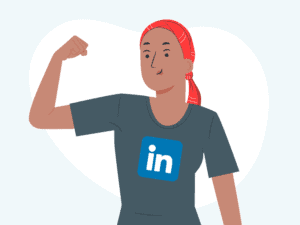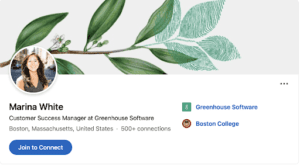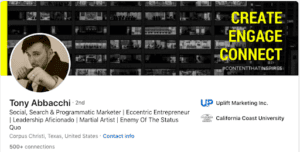If you have to reach out to prospects and leads on a regular basis, you’re likely already more than familiar with the power of LinkedIn. As a platform that’s completely dedicated to professional networking, the well of potential clients is unrivaled.
However, the fact is that first impressions count and you may be sabotaging your chances of connecting with new prospects before you’ve even created your next leads list. It doesn’t matter how good your lead generation strategy is or the emailing sequence you have set up afterwards, if your profile isn’t up to scratch, you’ll find it difficult to convert the numbers you need.
How important is your LinkedIn profile?
It’s tempting to think that it doesn’t matter how professional your profile is. As long as it isn’t unprofessional, you are bound to be able to tap into the 740 million members that are part of the platform, right?
After all, LinkedIn is 277% more effective at generating leads than Facebook and Twitter, according to Hubspot, so it shouldn’t make that much of a difference.
Well, no.
Unfortunately, all that potential is wasted if prospects decide that your profile doesn’t look right. What’s worse is that it takes just seven seconds for them to make up their mind.
But it’s not just about people’s perception. Optimizing your profile will also influence your visibility on the platform and help potential leads find you!
In the end, no matter what way you look at it, it’s simply vital that your profile is as good as it possibly can be if you want to succeed in B2B LinkedIn sales.
Strengthening your LinkedIn Profile

There are many steps you can take to strengthen your LinkedIn profile and appeal to prospects and leads.
Your picture says a lot about you
When you go onto a person’s profile, what’s the first thing you fix on? For the vast majority of us, it’s the profile picture.
If you’re trying to convince leads that you’re worth replying to, your picture needs to convey that you are trustworthy, approachable—and professional. This last one is particularly important because we have a broad idea of what it means to be professional.
Not only should you be smiling and well dressed, but the quality of the photo should be up to standard. Ideally, the photo should be taken specifically for your profile, and not cut from a party or zoomed in on.
LinkedIn photo best practices:
Want a new photo? Here are some best practices for taking your LinkedIn photo.
- Make sure that it looks like you.
- Use high-resolution images (400 x 400 pixels).
- Your face should be 60% of the photo.
- Make sure nobody else is in the picture.
- Avoid selfies if possible.
- No distracting backgrounds (use soft, natural light).
- Wear professional attire.
Here’s a nice example:

Stand out with a cover story
Times have changed. With LinkedIn, that means you now have the opportunity to add a 30-second video to your profile picture. If you haven’t noticed this feature yet, it’s when an orange ring appears around your picture. When the ring is there, that means there’s a video you can watch.
The benefit of this is that you get the chance to introduce yourself exactly how you want to. It can show off your communication skills, your passion for your job, or literally anything else you can imagine.
Given that trust plays such an important role in sales outreach, having the opportunity to build trust with a video can really make the difference in how many responses you get.
Have you got a cover photo yet?
Never mind the cover story, many of us haven’t quite managed to get our cover photo quite right yet. This is the long photo in landscape at the top of your profile, which is another incredible opportunity to make the right impression instantly. After all, every second counts.
Much of the cover photo’s importance (this also applies to your photo and the story) can be tied back to the famous statistic that people remember 80% of what they see—but only 20% of what they read.
For example, if you put your company’s logo in the background, you are maximizing the chances of leads remembering you. And simply recognizing you goes a long way in establishing trust.
What’s more, there’s two sides to the coin with cover stories. Not only can a good one boost your chances of getting replies, but not having one can be interpreted as unprofessional. After all, if you can’t be bothered sorting out your profile, why should they bother responding to you?
Get creative with your headline

For years, we’ve heard about the importance of having your elevator pitch down, whether you’re trying to pitch a business idea, get a new job, or anything else.
Your headline on LinkedIn performs exactly the same function. The only difference is you don’t need to wait until you are stuck in an elevator with just the right person. Anybody who sees your profile will be automatically “pitched” to. So, what do you want them to know?
For example, if it simply says “Sales Professional at [your company],” people will likely be turned off because nobody wants to be sold at.
Instead, concentrate on the benefits you offer anyone who works with you. If your company specializes in offering best-in-class lead-generation software (like we do at Prospects.so), it might say:
Founder of Prospects.so | Freeing business owners up to connect with their ideal customers.
See the difference?
Continue your elevator pitch
The headline should get their attention—but it’s not the entire elevator pitch. Everywhere on your profile is a chance to pitch to new leads. And another powerful example of this is the summary.
In total, you have 2,000 characters to play with. But it’s worth keeping in mind that most users will only see the first 300 characters and most of those won’t click on the “read more” to get the full description.
That means you have 300 characters to really wow your audience, and use relevant keywords that can help boost your visibility.
Now, while your LinkedIn profile is about you, it’s more effective to write this part for your target audience (unless you actually are hoping to land a new job!).
What we’re trying to say here is that, although LinkedIn is a professional space, if you have a target that will likely respond to humor, you can inject it here.
Take this one for example:


Tony has taken a risk here, and it will like work, as he is trying to brand himself as an “eccentric” entrepreneur. However, it can also fall flat if you misjudge your target.
About summary best practices:
You have a lot of freedom with this part. But here are some general guidelines to use when crafting your own:
- Make your first sentence count
- Describe your passion
- Explain your present role
- Frame your past
- Highlight your successes
- Reveal your character
- Use keywords
- Avoid jargon
Cultivate your network

Referrals are powerful tools in building trust and establishing relationships. But it’s not always possible to get them. However, there is another way that’s almost as good, which is to contact people with shared connections.
Prospective leads are much more likely to trust you and reply if they see that you know the same people. Beyond that, you can even incorporate it into your messaging by mentioning shared connections by name.
The more connections you have, the more opportunities you have to connect with individuals. Of course, this doesn’t mean you should be indiscriminately adding people to your network. Always remember the context to ensure that you don’t come across as spam.
Endorse and recommend
The more endorsements you give and receive, the better. Firstly, it’s just nice to give your connections your support whenever you think they deserve it. It can be the deciding factor in them being offered a new position or can just give them a little confidence boost.
Also, they’re more likely to endorse you back. The reason it’s important to have endorsements is because they are actually rumored to affect the algorithm, so you are more likely to be visible. It also impacts the trust perception, meaning more leads are likely to accept and respond to your messages.
This same logic applies to (and perhaps even surpasses) recommendations, which are literal votes of confidence in you and your abilities. What we said above about the importance of referrals plays a part here. Even if it’s not specifically about the topic in hand, having references on your character can go a long way in building trust.
Complete your LinkedIn profile!
Wherever possible, don’t leave blank spaces. There are a couple reasons for this, such as making sure you are well perceived by potential leads. However, there’s also a more instantly practical reason—LinkedIn likes a fully complete profile. If they rate your profile as advanced, you will be more likely to show up in search results!

Another quick tip is to use keywords that are related to the industry you are targeting throughout your profile. Remember that it’s not just about outreach, sometimes people will actively find you.
To do that, you should think about what keywords your potential clients, co-workers, etc. would be using and sprinkle them into your copy.
Remember to make it human

Yes, LinkedIn is a professional networking site and you should definitely be more formal than on other social media sites like Facebook and Instagram, to name a few. But you are still there to appeal to other people and that means your professionalism shouldn’t get in the way of your humanity and personality.
Wherever you are filling out a section on the platform, remember to include your passions and interests. By simply showing that you have a life outside of work or that your work truly excites and enriches you, you are more likely to appeal to other users and get a response.
Of all the advice we’ve given in this post, keeping it human is probably the most important. There’s a temptation with automation software and sales sequences to think that your efforts are more impersonal and removed. But the exact opposite is true.
With Prospects.so, the tedious, impersonal tasks are taken care of for you. In the end, all that’s left is true connection. By curating your leads list, personalizing your messaging, and improving your LinkedIn profile, you can reach a wider audience—and in a more authentic way.
If you’d like to find out more about how Prospects.so can help you capture more leads, reach out to us today for more information!

